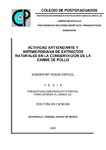Actividad antioxidante y antimicrobiana de extractos naturales en la conservación de la carne de pollo.
Abstract
El presente estudio tuvo como objetivos: 1) Evaluar la actividad antioxidante (AA) y antimicrobiana (AM) de los extractos de orégano (Origanum vulgare), tomillo (Thymus vulgaris), albahaca (Ocimum basilicum L.), cáscara de naranja (Citrus sinensis, variedad valencia), cáscara de mandarina (Citrus reticulata), cáscara de mango (Mangifera indica cv. Ataulfo) y cáscara de guayaba (Psidium guajava L.), obtenidos por maceración (MC) o ultrasonido (US); 2) Seleccionar los tres extractos con mejor AA y AM y evaluarlos a diferentes concentraciones (50, 37.5, 25.5 y 12.5 mg mL-1) para elegir aquella más adecuada; 3) Analizar el efecto de los tres extractos en la oxidación de lípidos, conteo microbiológico, pH y color en la carne de pollo almacenada a 4 ± 1 °C por 15 días. El contenido de fenoles (FE) y flavonoides (FL) se determinó por el método de Folin-Ciocalteu y colorimétrico, respectivamente; la AA de los extractos por el método DPPH; y la AM se evaluó frente a Salmonella Typhimurium, Escherichia coli y Pseudomonas fluorescens por el método de difusión en agar. En las muestras de carne con extractos se midió la oxidación de lípidos por el contenido de TBARS, conteo microbiológico de cuenta total viable (CTV), Enterobacteriaceae (EN) y Pseudomonas spp (PS), pH y color (L*, a* y b*). De los siete extractos obtenidos por US o MC, los extractos de tomillo (E-TO), cáscara de mango (E-MA) y cáscara de guayaba (E-GU) por US presentaron la mejor (p<0.05) AA y AM. De estos tres extractos, el mayor contenido de FE, FL, asi como la más alta AA y AM se obtuvo con la concentración de 50 mg mL-1. Los E-TO y E-MA, redujeron (p<0.05) la oxidación de lípidos y el crecimiento microbiano de CTV, EN y PS, en comparación con el conservador sintético (BHT), al finalizar el período de almacenamiento. Adicionalmente, se preservaron el pH y el color de la carne, contribuyendo a extender la vida útil de la carne de pollo. El E-GU no tuvo efecto favorable (p<0.05) en la conservación de la carne de pollo al compararse con el BHT. Los E-TO y E-MA obtenidos por US tienen efecto favorable en la conservación de la carne de pollo. _______________ ANTIOXIDANT AND ANTIMICROBIAL ACTIVITY OF NATURAL EXTRACTS IN THE CONSERVATION OF CHICKEN MEAT. ABSTRACT: The present study had as objectives: 1) To evaluate the antioxidant (AA) and antimicrobial (AM) activity of extracts of oregano (Origanum vulgare), thyme (Thymus vulgaris), basil (Ocimum basilicum L.), orange peel (Citrus sinensis, variety Valencia), mandarin peel (Citrus reticulata), mango peel (Mangifera indica cv. Ataulfo) and guava peel (Psidium guajava L.), obtained by maceration (MC) or ultrasound (US); 2) Select the three extracts with the best AA and AM and evaluate them at different concentrations (50, 37.5, 25.5 and 12.5 mg mL-1) to choose the most appropriate; 3) Analyze the effect of the three extracts on lipid oxidation, microbiological count, pH and color in chicken meat stored at 4 ± 1 °C by 15 days. The content of phenols (FE) and flavonoids (FL) was determined by the Folin-Ciocalteu and colorimetric method, respectively; the AA of the extracts by the DPPH method; and AM was evaluated against Salmonella Typhimurium, Escherichia coli and Pseudomonas fluorescens by the agar diffusion method. In the meat samples with extracts, the lipid oxidation was measured by the content of TBARS, microbiological count of total viable count (CTV), Enterobacteriaceae (EN) and Pseudomonas spp (PS), pH and color (L*, a* and b*). Of the seven extracts obtained by US or MC, the extracts of thyme (E-TO), mango peel (E-MA) and guava peel (E-GU) by the US presented the best (p<0.05) AA and AM. Of these three extracts, the highest content of FE, FL, as well as the highest AA and AM was obtained with a concentration of 50 mg mL-1. The E-TO and E-MA, reduced (p<0.05) the lipid oxidation and the microbial growth of CTV, EN and PS, in comparison with the synthetic preservative (BHT), at the end of the storage period. Additionally, the pH and color of the meat were preserved, helping to extend the shelf life of the chicken meat. The E-GU did not have a favorable effect (p<0.05) on the conservation of chicken meat when compared to the BHT. The E-TO and E-MA obtained by the US have a favorable effect on the preservation of chicken meat.
Collections
- Tesis MC, MT, MP y DC [403]


